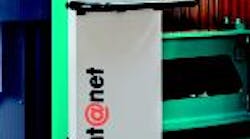The terminal was developed by an industrial designer to conform to modern workstation standards, with height and angle adjustable to operators' needs.
Recognizing that diecasters will benefit from a centralized control system, Bühler AG has introduced dat@net. Based in Uzwill, Switzerland, Bühler is one of the world's leading supplier of diecasting system, and the originator of several recent advances in the diecasting technology.
The dat@net is Bühler's latest innovation replacing the various interfacing sensors, actuators, and control programs used to oversee diecasting. For the first time, diecasting cells can be controlled from a centralized unit, without peripheral controls. More important, the developers contend that it makes possible more than smooth machine operation: it ensures the diecasting operation is efficient and flexible, easy to program and effective in its diagnostic capability.
Dat@net is based on hardware and software that have been carefully developed specifically for the diecasting process. The package includes control and measuring technology; visualization programs; PC-based scaleable hardware; a built-in Web interface or network connection, with digital interface.
The operator terminal with touchpanel controls and TFT display is based on Bühler's established operator platform. All hardware and software platforms are structured in a modular system with their own power supply, meaning that future expansions of the diecasting operation can be accommodated by scaling up the control platform. Connections are done via optocouplers with data stored and reliably relayed using compact flashes.
System electronics are rugged enough for industrial use; with no hard disks to fail in harsh service, all the data is stored on flash cards — increasing the system's service life.
Dat@net's internal diagnostics check the status system components and the processes taking place in the control system. Internal conditions and interface signals are displayed graphically, so they can be pinpointed easily and quickly, reducing downtime. (Bühler has applied for a patent on this capability.)
Comprehensive diagnostics insure the operation against process failure, and all digital and analog inputs and outputs are saved and visualized online. According to developers, these diagnostic functions make it possible to gather reliable information on process faults, and the built-in Web connection makes it possible to reference Bühler's diecasting engineers for remote troubleshooting service.
Maintenance alerts are automatically signaled from the Bühler control center to the operator.
Furthermore, process operation is easy to understand. Operators may use the control panel to revise I/O data without resorting to programming language. The Bühler Dataspeed platform is widely recognized as a diecasting industry standard for casting cell control, so training (and retraining) are not serious concerns for operations that adopt dat@net.
The operator's terminal is reported to be ergonomically satisfactory for operators. The touchscreen was developed by an industrial designer to conform to modern workstation standards, with height and angle adjustable to operators' needs.
Bühler offers two cell control designs that integrate metal ladling, diecasting, die spraying, and part extraction:
The single cell includes a ladling device, a diecasting machine, a radial die spray unit, and a pick-and-place device.
The "high-convenience" cell includes a ladling furnace, a diecasting machine, a die-spray unit, and an ABB robot.
According to one report, Bühler's future development of the dat@net process is concentrating on image enhancement, expanded integration of peripheral equipment, new interface techniques (such as USB and Ethernet), and increased electronics lifecycle of the electronics.










